168: Difference between revisions
Pbcjohnston (talk | contribs) Added more photos |
Pbcjohnston (talk | contribs) Finished adding photos |
||
| Line 91: | Line 91: | ||
[[File:Red bar sub new 2.jpg]] | [[File:Red bar sub new 2.jpg]] | ||
[[File:Nautilus pearl 1934-1a.jpg|left|500px]] | |||
<div style="text-align: justify;"><span style="color:#00008B">A fine shot of the Nautilus steaming past the seaplane tender USS Wright (AV-1) and the Navy's first aircraft carrier, the USS Langley (CV-1). This is at an unknown west coast port, and was taken during fleet maneuvers in April, 1932. The Langley's boilers are lit off and smoke is coming out of one of her folding funnels. To clear the decks for airplane operations the funnels would fold out sideways to the hull. The Langley's hanger deck was open to the elements. | |||
Various crew are on deck aboard Nautilus and it is unclear if she is heading to sea or returning. There isn't any obvious line handling activity going on. | |||
<small>Original Photo in the Private Collection of Ric Hedman</small> | |||
[[File:Red bar sub new 2.jpg]] | |||
[[File:Nautilus Argonaut.jpg|left|500px]] | |||
<div style="text-align: justify;"><span style="color:#00008B">Nautilus (left) with [[V-4|'''Argonaut (SM-1)''']] (right) along with what is likely [[167|'''Narwhal (SS-167)''']] (far right) sometime in 1932 at a west coast port, possibly San Francisco. The slits in the bow of both Nautilus and Argonaut are for the retracted mine cutting gear. | |||
<Small>U.S. Navy photo</small> | |||
[[File: | [[File:Red bar sub new 2.jpg]] | ||
[[File:Nautilus PH 1942.jpg|left|500px]] | |||
<div style="text-align: justify;"><span style="color:#00008B">An overhead view of Pearl Harbor Navy Yard, July 28, 1942. Floating drydock YFD-2 is at left, with USS Alywin (DD-355) inside. Small drydock in center holds USS Growler (SS-215) and USS Nautilus (SS-168). USS Litchfield (DD-336) and an ARD floating drydock are in Drydock # 2, in right center. Drydock # 1, at right, contains the heavily damaged and recently salvaged USS West Virginia (BB-48). Submarines partially visible alongside 1010 Dock, in the extreme upper right, are USS Trout (SS-202) and USS Pollack (SS-180). | |||
<Small>U.S. Navy photo</small> | |||
[[File:Red bar sub new 2.jpg]] | |||
[[File:Nautilus stores.jpg|left|500px]] | |||
<div style="text-align: justify;"><span style="color:#00008B">Nautilus' crew conducting a stores loading "party", December 11, 1942 in preparation for her fourth war patrol. The location is Submarine Base Pearl Harbor. The man in the left foreground is carrying two cases of Corn Flakes. The next man is carrying a case labeled Durkees and could contain almost any of their products but possibly pickles or salad dressing. | |||
Barely visible in the photo is a large section of deck that has been removed to gain access to the systems in the free flood area. The sections removed can be seen on the pier to the right and above the gangway. | |||
<small>US Navy Photo in the private collection of Ric Hedman</small> | |||
[[File:Red bar sub new 2.jpg]] | |||
[[File:Nautilus stores 2.jpg|left|500px]] | |||
<div style="text-align: justify;"><span style="color:#00008B">Nautilus taking on previsions for departing Pearl Harbor 11 December 1942 prior to her fourth war patrol. The following is an excerpt from her patrol report: "During her fourth patrol, conducted in the Solomons 13 December 1942 to 4 February 1943, NAUTILUS rescued 26 adults and 3 children from Toep Harbor (31 December-1 January), then added the cargo ship YOSINOGAWA MARU to her kills and damaged a tanker, a freighter and a destroyer. On 4 February, she arrived at Brisbane, disembarked her passengers, and sailed for Pearl Harbor." Toep Harbor is on Bougainville Island in the northern Solomons. | |||
<small>US Navy Photo in the private collection of Ric Hedman</small> | |||
[[File:Red bar sub new 2.jpg]] | [[File:Red bar sub new 2.jpg]] | ||
Revision as of 20:25, 23 June 2023
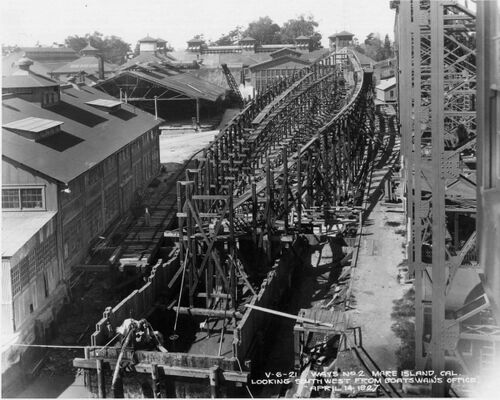
U.S. Navy photo courtesy Darryl Baker
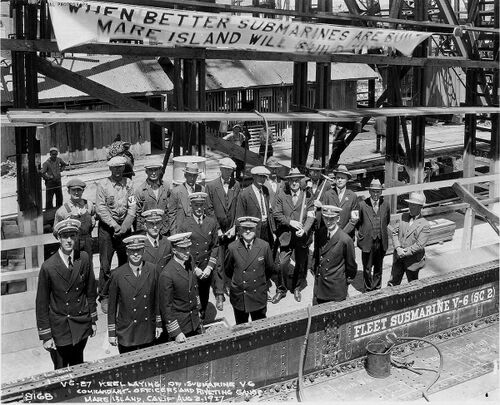
From left to right: Front row; LT J. W. (Duke) Paige, C.C., Ship Supt; CDR E. L. Patch, C.C., Asst. Inside Supervisor, New Work Hull (In general charge of Keel Laying Arrangements); CDR F. J. Wille, Outside Supt.; CAPT C. S. McDowell, Inside Supt.; LCDR W. C. Wade, Asst. Shop Supt.; RADM J. H. Dayton, Commandant Mare Island Navy Yard; CDR E. D. (Bill) Almy, Shop Supt.; J. T. Moroney, Master Shipfitter.
Back Row: Fred Coppo, Rivet Heater; A. P. Schneidewind, Riveter; J. F. Nichelini, Holder-on (all members of regular riveting gang); Honorary Riveting Group: A. L. Luck, Leadingman Shipwirght "Riveter"; W. L. Blackmore, Leadingman Pipefitter "Rivet Passer"; J. E. Moon, Leadingman Machinist "Rivet Heater"; Charles Deaver, Quarterman Riveter "Rivet Heater"; Tom Schofield, Master Rigger & Laborer "Holder-on"; B. A. (Bert) Barr. Quarterman Shipfitter "Riveter"; F. W. Savage, Quarterman Electrician "Rivet Tester"; J. R. Greig, Asst. Shop Supt. "Rivet Tester.
The primary construction method was obviously riveting. But at this time there were experiments underway at Navy yards to incorporate welding. Although not shown in this photo, some non-critical areas such as pipe brackets, superstructure supports, and interior deck joinery were welded.
U.S. Navy photo courtesy Darryl Baker
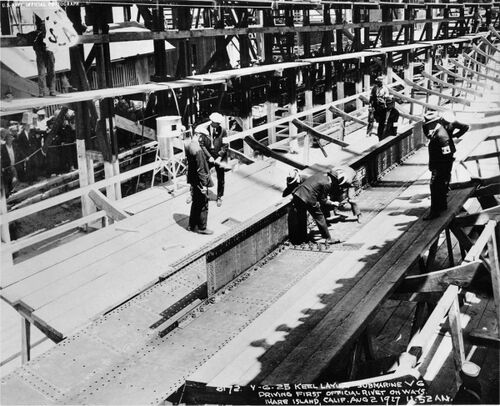
U.S. Navy photo courtesy Darryl Baker
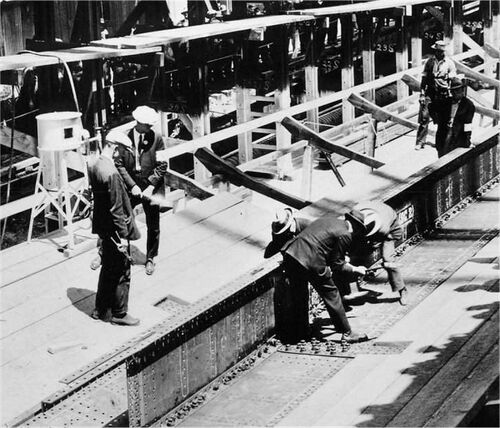
U.S. Navy photo courtesy Darryl Baker
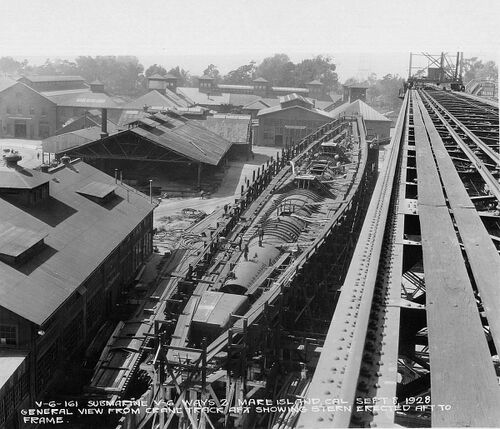
U.S. Navy photo courtesy Darryl Baker
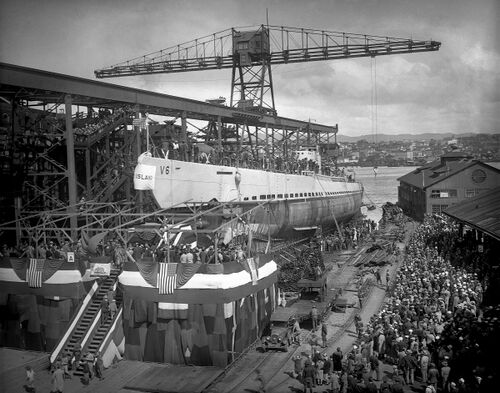
From orignial glass plate negatives in the private collection of Ric Hedman.
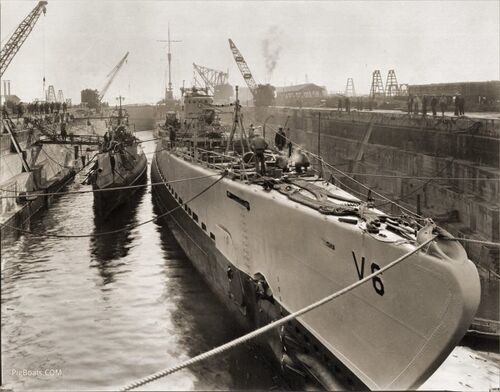
Photo in the private collection of Rid Hedman.
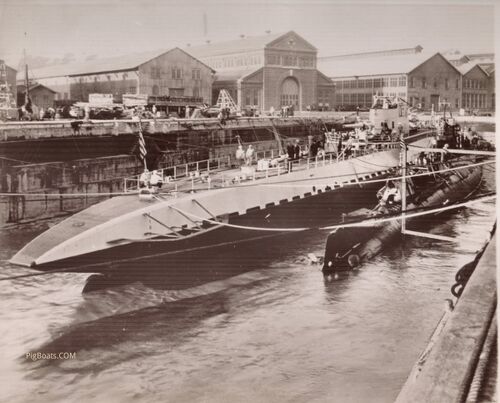
Photo in the private collection of Rid Hedman.
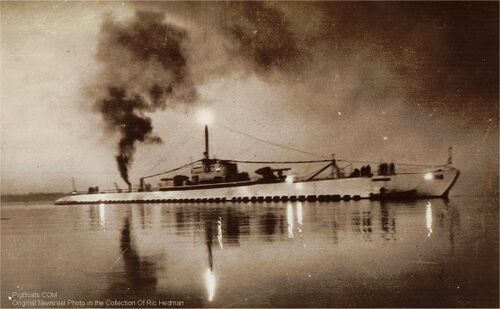
It appears that the V-6 has an oil fired boiler or furnace in her engine room, similar to V-4, as indicated by the heavy black smoke coming from a stack in her after deck. As far as we can tell this is the only photo known to show this feature on V-6. It doesn't seem to be mentioned in any literature about her.
All her running lights and anchor lights seem to be lit and reflecting in the calm pre-dawn waters. The dateline is Seattle, Washington so this may be Puget Sound. The photo is a bit fuzzy probably since the photo was taken from a small boat in the water near the V-6, maybe even from one of her own boats. One of them is seen in the water by the bow planes.
Original Newsreel photo in the private collection of Ric Hedman.

Newspaper Wire photo in the private collection of Ric Hedman.
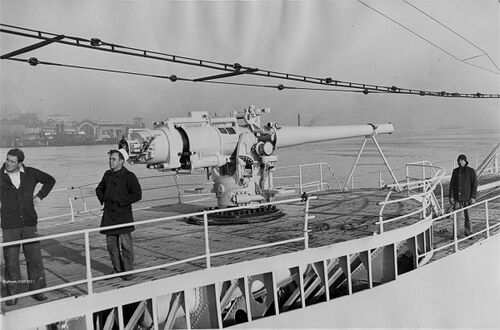
The building in the background is the old St. Georges Ferry Terminal on Staten Island. It burned to the ground in 1946. According to retired Navy Commander Gerald Levey USN, a native of New York; "The ferry terminal is definitely the St George terminal, The ferry, (to the left of the building, twin stacks), is one of the five Dongan Hills class built in 1931. You can date the photo between 1931 and 1946 when the old terminal burned to the ground. It is a rare photo as the three definitive books on the Staten Island Ferries have no decent photos of that terminal as seen from an approaching ferry."
The truly massive size (for a submarine at least) of the 6"/53 caliber guns is very evident in this photo. These were the largest guns ever mounted on a USN submarine.
Photo in the private collection of Ric Hedman.
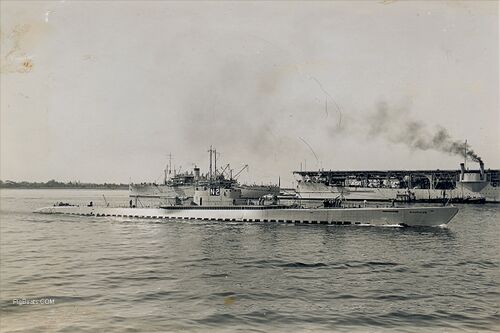
Various crew are on deck aboard Nautilus and it is unclear if she is heading to sea or returning. There isn't any obvious line handling activity going on.
Original Photo in the Private Collection of Ric Hedman
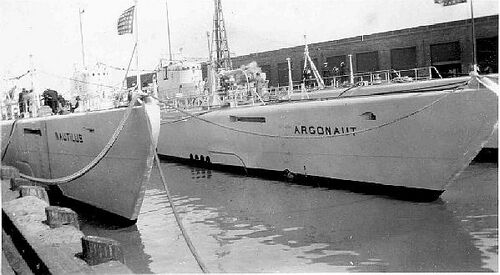
U.S. Navy photo
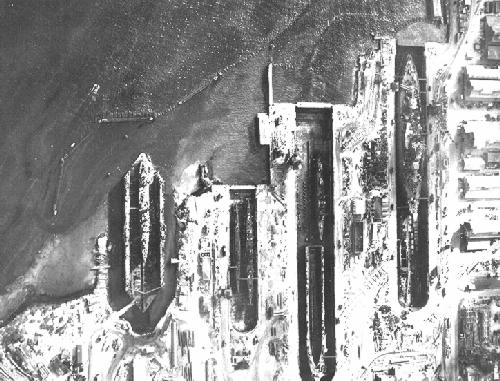
U.S. Navy photo
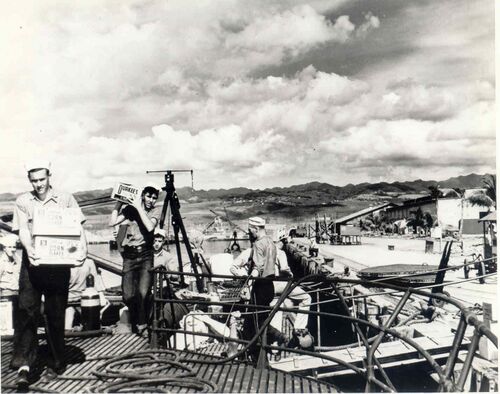
Barely visible in the photo is a large section of deck that has been removed to gain access to the systems in the free flood area. The sections removed can be seen on the pier to the right and above the gangway.
US Navy Photo in the private collection of Ric Hedman
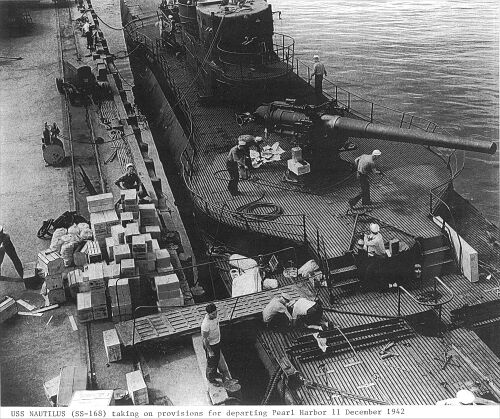
US Navy Photo in the private collection of Ric Hedman
Page created by:
Ric Hedman & David Johnston
1999 - 2023 - PigBoats.COM©
Mountlake Terrace, WA, Norfolk, VA
webmaster at pigboats dot com
